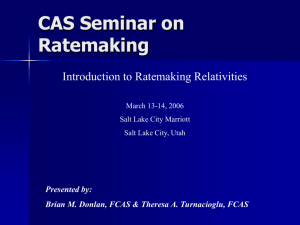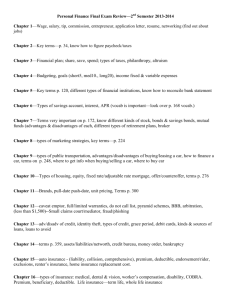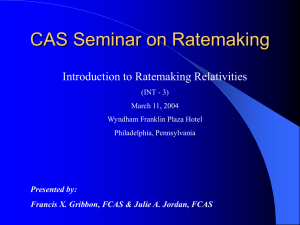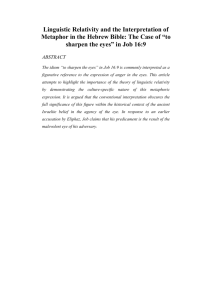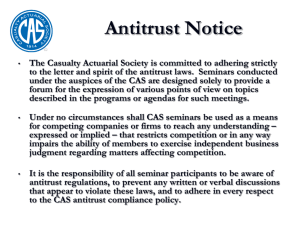CAS Seminar on Ratemaking - Casualty Actuarial Society
advertisement
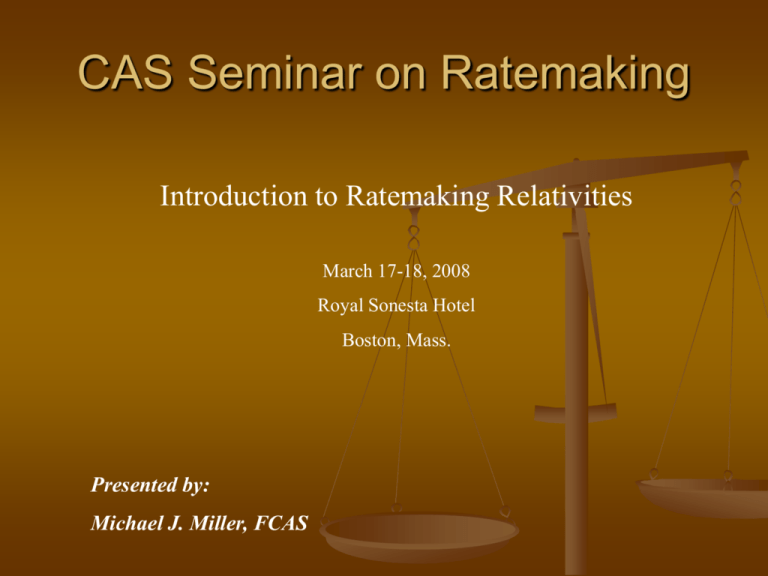
CAS Seminar on Ratemaking Introduction to Ratemaking Relativities March 17-18, 2008 Royal Sonesta Hotel Boston, Mass. Presented by: Michael J. Miller, FCAS Introduction to Ratemaking Relativities What is the purpose of rate relativities? Considerations in determining rating distinctions Basic methods and examples Advanced methods The Purpose of Rate Relativities Example – Personal Auto: Overall Indicated Change for State = +10% Should everyone’s rate be increased by 10%? Same for youthful drivers vs. adults? Same for urban vs. rural? Same for all policy limits? Deductibles? The Purpose of Rate Relativities Example: Base Rate = $100 (Adult, Terr 1, No Deductible) Insured Age Territory Deductible Premium Male Age 40 Terr 1 $0 Ded 1.00 1.00 1.00 $100 Male 18 Terr 2 $500 Ded 3.50 1.50 0.60 $315 Female 18 Terr 2 $100 Ded 2.00 1.50 0.85 $255 Considerations in Selecting Rate Relativities Actuarial (Statistical) Operational Social Legal Actuarial Considerations Accuracy Rating variable closely related to cost differences Provides “fairest” price (fair discrimination) Reduces adverse selection (discussed later) Homogeneity Members of a class have similar expected cost Variability within class always exists – grouping is necessary since individual lacks credibility Actuarial Considerations (cont.) Credibility Class groups should be large enough to measure costs with sufficient accuracy There is a trade-off between the need to estimate costs accurately for an individual and the need for enough data to do it. Reliability Estimated cost differences between groups should be relatively stable over time This does not mean they will be the same over time Adverse Selection Adverse selection can result when a group can be accurately separated into 2 or more distinct groups, but has not been. Consider the following scenario: Group A expected costs = $100 Group B expected costs = $200 Your company charges $150 for both Competitor charges $100 for A, and $200 to B Adverse Selection (cont.) At the outset, your company is collecting enough to cover expected costs for both groups. Life is good. All of your insureds in Group A learn about your competitor’s lower rate and switch. Your company is left with all of Group B at a $150 rate. You have been selected against! Typically this process happens gradually Operational Considerations Objective - Age & Marital Status vs “Maturity” Administrative expense – Actual mileage driven may be better predictor of accident potential than where an insured lives, but one is much cheaper to obtain Verifiability – The amount of sleep a person has gotten in the previous 24 hours may be a significant predictor of auto accident potential. Aside from the expense of trying to get this information, how could it be verified? Social Considerations Privacy – certain personal info is off limits Causality – as opposed to correlation Controllability – something the insured can Affordability – impact (e.g. install sprinklers in commercial property, non-smoker in health insurance) balance with availability (e.g. hospitals closing ER and OB due to high cost of med mal insurance for these classes) Legal Considerations Choice of rating variable may be prohibited by law at many levels (e.g. Federal, State). Some examples: Race Gender (always in Health ins, sometimes in other lines – even auto) Income Basic Methods for Determining Rate Relativities Loss ratio relativity method Compare “actual” LR to expected LR to produce an indicated change in relativity Pure premium relativity method Develop expected cost per unit of exposure to produce indicated relativity The methods produce identical results when identical data and assumptions are used. Data and Data Adjustments Policy Year or Accident Year data Premium Adjustments (LR method) Current Rate Level Premium Trend/Coverage Drift (not typical) Loss Adjustments Loss Development (project to ultimate) Loss Trend (project to same time period) Coverage Adjustments (diff Ded’s, Limits?) Catastrophe Adjustments (“Shock Losses”) Loss Ratio Relativity Method Class Premium @CRL 1 $1,168,125 2 Trended & Developed Losses Loss Ratio Loss Ratio Adjustmt Current Relativity New Relativity $759,281 0.65 1.00 1.00 1.00 $2,831,500 $1,472,719 0.52 0.80 2.00 1.60 Pure Premium Relativity Method Class Exposures 1 6,195 2 7,770 Trended & Developed Losses Pure Premium Pure Premium Relativity $759,281 $123 1.00 $1,472,719 $190 1.55 Incorporating Credibility Credibility: how much predictive weight do you assign to a given body of data? Credibility is usually designated by Z Credibility Weighted Loss Ratio: LR= (Z) * LRclass + (1-Z) * LRcomplement Methods to Estimate Credibility Judgmental Bayesian Z = E/(E+K) E = exposures K = expected variance within classes / variance between classes Classical / Limited Fluctuation Z = (n/k).5 n = observed number of claims k = full credibility standard Loss Ratio Method, Continued Class Loss Ratio Credibility Credibility Weighted Loss Ratio Loss Ratio Adjustmt Current Relativity New Relativity 1 0.65 0.50 0.61 1.00 1.00 1.00 2 0.52 0.90 0.52 0.85 2.00 1.70 Total 0.56 Off-Balance Adjustment Class Premium @CRL Current Relativity Premium @ Base Class Rates Proposed Relativity Proposed Premium 1 $1,168,125 1.00 $1,168,125 1.00 $1,168,125 2 $2,831,500 2.00 $1,415,750 1.70 $2,406,775 Total $3,999,625 Impact on Current Premium (“Off-Balance”) $3,574,900 -11.9% Off-balance of 11.9% must be covered in base rates. (How?) Multivariate Techniques Univariate (One-Way) Analyses: Based on assumption that effects of single rating variables are independent of all other rating variables Multivariate Analyses: Give consideration to the correlation or interaction between rating variables Multivariate Techniques (cont.) Bailey’s Method Least Squares Method Generalized Linear Model (GLM) Method Example: Bailey’s Method 2 rating variables with relativities Xi and Yj Select initial value for each Xi Use model to solve for each Yj Use new Yjs to solve for each Xi Process continues until solutions at each interval converge Bailey’s Minimum Bias “Balance Principle” : ∑ observed relativity = ∑ indicated relativity i.e., ∑j wijrij = ∑j wijxiyj where Xi and Yj = relativities for rating variables i and j wij = weights rij = observed relativity Bailey’s Minimum Bias Formula: Xi = ∑j wij rij ∑j wij Yj where Xi and Yj = relativities for rating variables i and j wij = weights rij = observed relativity Bailey’s Minimum Bias Less sensitive to the experience of individual cells than Least Squares Method Widely used; e.g.., ISO GL loss cost reviews A Simple Bailey’s ExampleManufacturers & Contractors Aggregate Loss Costs at Experience Ratio Current Level (wij) Class Group Type of Class Group (CGj) Light Manuf Medium Manuf Heavy Manuf Light Manuf Medium Manuf Heavy Manuf Monoline 2000 250 1000 1.10 .80 .75 Multiline 4000 1500 6000 .70 1.50 2.60 Policy SW = 1.61 Bailey’s Example Experience Ratio Relativities Class Group (CGj) Type of Policy (TOPi) Statewide Light Manuf Medium Manuf Heavy Manuf Monoline .683 .497 .466 .602 Multiline .435 .932 1.615 1.118 Bailey’s Example Initial guess for relativities of one variable (e.g., TOP: Mono = .602; Multi = 1.118) Use TOP relativities and Bailey’s Minimum Bias formulas to determine the Class Group (CG) relativities Bailey’s Example CGj = ∑i wij rij Class Group Bailey’s Output Light Manuf .547 Medium Manuf .833 Heavy Manuf 1.389 ∑i wij TOPi Bailey’s Example What if we continued iterating? Step 1 Step 2 Step 3 Step 4 Step 5 Light Manuf .547 .547 .534 .534 .533 Medium Manuf .833 .833 .837 .837 .837 1.389 1.389 1.397 1.397 1.397 Monoline .602 .727 .727 .731 .731 Multiline 1.118 1.090 1.090 1.090 1.090 Heavy Manuf circled factors = newly calculated; continue until factors stop changing Bailey’s Can be used for multiplicative or additive rating relativities Can be used for many dimensions (convergence may be difficult) Easily coded in spreadsheets Least Squares Method Minimize weighted squared error between the indicated and the observed relativities i.e., Min xy ∑ij wij (rij – xiyj)2 where Xi and Yj = relativities for rating variables i and j wij = weights rij = observed relativity Least Squares Method Formula: Xi = where ∑j wij rij Yj ∑j wij ( Yj)2 Xi and Yj = relativities for rating variables i and j wij = weights rij = observed relativity Generalized Linear Models Generalized Linear Models (GLM) provide a generalized framework for fitting multivariate linear models User-friendly software allows for ease of changing assumptions, adding variables, testing results, visual depiction of actual and expected results Methodology based on Maximum Likelihood Generalized Linear Models ISO Applications: Businessowners, Commercial Property (Variables include Construction, Protection, Occupancy, Amount of insurance) GL, Homeowners, Personal Auto Suggested Readings ASB Standards of Practice No. 9 and 12 Foundations of Casualty Actuarial Science, Chapters 3 (Ratemaking) & 6 (Risk Classification) Insurance Rates with Minimum Bias, Bailey (1963) The Minimum Bias Procedure – A Practitioners Guide, Feldblum et al (2002) Suggested Readings Something Old, Something New in Classification Ratemaking with a Novel Use of GLMs for Credit Insurance, Holler, et al (1999) A Practitioners Guide to Generalized Linear Models, Anderson, et al A Systematic Relationship Between Minimum Bias and Generalized Linear Models, Mildenhall (1999) Deductible Credits Insurance policy pays for losses left to be paid over a fixed deductible Deductible credit is a function of the losses remaining Since expenses of selling policy and non claims expenses remain same, need to consider these expenses which are “fixed” Deductible Credits (cont.) Deductibles relativities are based on Loss Elimination Ratios (LER’s) The LER gives the percentage of losses removed by the deductible Losses lower than deductible Amount of deductible for losses over deductible LER = (Losses<= D)+(D * # of Clms>D) Total Losses Deductible Credits (cont.) F = Fixed expense ratio V = Variable expense ratio L = Expected loss ratio LER = Loss Elimination Ratio Deductible credit = L*(1-LER) + F (1 - V) Deductible Credits (cont.) Example: Loss Elimination Ratio Loss Size # of Claims Total Losses Average Loss 0 to 100 500 30,000 101 to 200 350 201 to 500 Loss Eliminated by Deductible $100 $200 $500 60 30,000 30,000 30,000 54,250 155 35,000 54,250 54,250 550 182,625 332 55,000 110,000 182,625 501 + 335 375,125 1120 33,500 67,000 167,500 Total 1,735 642,000 370 153,500 261,250 434,375 0.239 0.407 .677 L.E.R. Deductible Credits (cont.) Example: Expenses Total Variable Fixed 15.5% 15.5% 0.0% Other Acquisition 3.8% 1.9% 1.9% Administrative 5.4% 0.0% 5.4% Unallocated Loss Expenses 6.0% 0.0% 6.0% Taxes, Licenses & Fees 3.4% 3.4% 0.0% Profit & Contingency 4.0% 4.0% 0.0% Other Costs 0.5% 0.5% 0.0% 38.6% 25.3% 13.3% Commissions Total Use same expense allocation as overall indications. Deductible Credits (cont.) Calculation of Deductible Factor Deductible Calculation Factor $100 (.614)*(1-.239) + .133 (1-.253) 0.804 $200 (.614)*(1-.407) + .133 (1-.253) 0.665 $500 (.614)*(1-.677) + .133 (1-.253) 0.444 Deductible Credits (cont.) Calculations above are at one point in time Need to perform calculation for deductible credits with each periodic review Compare results of most recent review to factors in place to decide if deductible factors need to change
